 Next: The bifurcation structure in
the (
Next: The bifurcation structure in
the ( , K)-plane
, K)-plane
 Next: The bifurcation structure in
the (
Next: The bifurcation structure in
the ( , K)-plane
, K)-plane
If we cut a section along K = 0.8 in Figure 1 we get an idea of the complex bifurcation structure inside the phase-locked region with zero rotation number. The tongue seems to consist of a set of bubbles that overlap slightly; see Figure 2
Along the line  = 0 we see
that a second attractor gets created in a pitchfork bifurcation as
= 0 we see
that a second attractor gets created in a pitchfork bifurcation as
 increases. Another pitchfork
bifurcation destroys the attractor again. However, in the second
region of overlap, the situation is more complicated, as can be seen
in Figure 3 (right), Figure 4
and Figure 5.
increases. Another pitchfork
bifurcation destroys the attractor again. However, in the second
region of overlap, the situation is more complicated, as can be seen
in Figure 3 (right), Figure 4
and Figure 5.
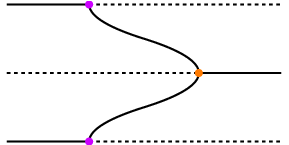
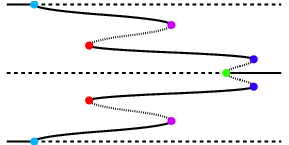
Figure 3:
Sketch of the bifurcations along the line  = 0 and K = 0.8 in the first (left) and the
second (right) overlap. Shown are invariant circles (represented by
one point) versus
= 0 and K = 0.8 in the first (left) and the
second (right) overlap. Shown are invariant circles (represented by
one point) versus  . Closed
curves represent stable and dashed curves represent unstable
circles. The colors correspond with the colors of the bifurcation
curves in Figure 2, Figure 4,
and Figure 5.
. Closed
curves represent stable and dashed curves represent unstable
circles. The colors correspond with the colors of the bifurcation
curves in Figure 2, Figure 4,
and Figure 5.

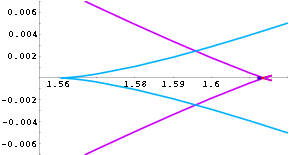


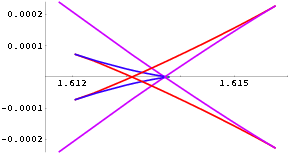

Figure 4:
The bifurcation structure for K = 0.8 in the second overlap
(left) seems to be the same as in Figure 2
(right). However, an enlargement (right) shows that the structure
is much more complicated.
Further enlargements of the second overlap in Figure 5 show the full complexity in the main tongue.

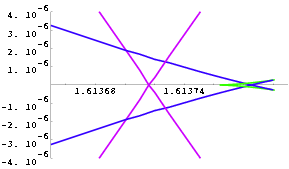


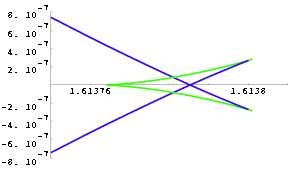

Figure 5:
Details of the bifurcation structure for K = 0.8 in the
second overlap. The last pitchfork bifurcation on the line  = 0 is subcritical (right) as
opposed to supercritical in Figure 2 (right).
= 0 is subcritical (right) as
opposed to supercritical in Figure 2 (right).
 Next: The bifurcation structure in
the (
Next: The bifurcation structure in
the ( , K)-plane
, K)-plane
Created by Hinke Osinga
Last modified: Wed May 17 16:11:12 2000